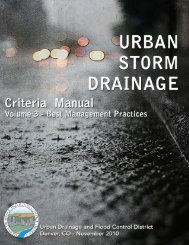BMP Monitoring Sites - Urban Drainage and Flood Control District
BMP Monitoring Sites - Urban Drainage and Flood Control District
BMP Monitoring Sites - Urban Drainage and Flood Control District
Create successful ePaper yourself
Turn your PDF publications into a flip-book with our unique Google optimized e-Paper software.
UDFCD <strong>BMP</strong> MONITORING SITES<br />
Pervious Concrete Pavement<br />
AASHTO #67 <strong>and</strong> the west pad used AASHTO #8. Below the surface, there<br />
are two lateral flow barriers in the form of concrete walls. At each barrier, the<br />
filtered water is collected in perforated pipes <strong>and</strong> carried to a manhole located<br />
adjacent to the pervious concrete pavement. Inside the manhole a riser pipe with<br />
an orifice is sized to drain the entire gravel pore volume of each cell<br />
in 6 hours or more. A riser pipe with a levelogger is located just upstream of<br />
each manhole to measure the flow coming from each cell. All flows from the<br />
pervious concrete pavement are combined <strong>and</strong> discharge east of the site through<br />
a V-notched weir where a pressure transducer measures the depth of flow<br />
<strong>and</strong> sends the data into the sampler.<br />
Adjacent to the pervious concrete pavement watershed is a control<br />
watershed of traditional asphalt pavement used to compare results of treated<br />
runoff to untreated, direct runoff. Stormwater runoff from the control watershed is<br />
collected in a sump catch basin at the northeast corner of the site. Water is<br />
conveyed a short distance to the outfall <strong>and</strong> flows through an H-flume where<br />
flow is measured by a pressure transducer.<br />
The sampling equipment is stored in a shed near the outlet works. A rain gage<br />
on top of the shed measures rainfall <strong>and</strong> signals the ISCO samplers inside the<br />
shed to begin sampling after 0.1 inches of rain falls. The samplers then draw a<br />
sample of water from both the pervious concrete pavement runoff <strong>and</strong> the control<br />
runoff after ??? cfs has passed, <strong>and</strong> then every 15 minutes until 12 hours after<br />
the storm has ended.
















